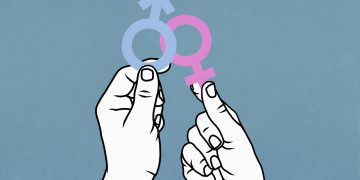Ask the average person how many sexes there are. Answer: Two.
Consult the Bible on how many sexes there are. Answer: “…male and female created he [God] them.” Genesis 1:27
Refer to Scientific American on how many sexes there are. Answer: “It depends.”
The answer to the question of how many sexes exist differs depending on the context | Analysis https://t.co/W68vMnVOA0
— Scientific American (@sciam) October 24, 2023
How the mighty have fallen.
Venerable Scientific American, in print since 1845 and on whose pages have been the likes of Albert Einstein and Nikola Tesla, has joined the nonsensical LGBT world regarding one of the most basic of issues — human sexuality.
And social media won’t tolerate such nonsense.
A simple question about how many sexes there are collapses into a burble of word mush in an October Scientific American article by Charles Roseman.
It’s like asking Scientific American what time it is and they tell you how to build a watch.
Sort of, since they would also wander about the timekeeping universe discussing sundials, egg timers, spring-powered mechanisms, and digital devices coupled with an analysis of time zones and how military Zulu Time equals Coordinated Universal Time.
But you still wouldn’t have your answer.
Same thing with Roseman’s Scientific American article entitled “To Understand Sex, We Need to Ask the Right Questions” as it skips about concepts regarding varied species “including bacteria and archaea” and how they reproduce, “sometimes mate with themselves or switch back and forth between sexual and asexual reproduction” and on and on.
But you still wouldn’t have your answer, since Scientific American is attempting to blur current discussions on who can participate in girls’ sports, coupled with hormone levels and more with the contemporary junk science surrounding transgenderism and LGBT issues (although they’re careful not to spell out those afflictions).
Roseman does admit there are disagreements about what constitutes sex, and points out how the American Anthropological Association and the Canadian Anthropology Society both jettisoned a panel discussion from their annual meeting that was about why biological sex remains important to anthropological research.
The topic apparently was too toxic “following concerns in the anthropological community that the panel conveyed antitransgender sentiment and decrepit ways of thinking about human variation.”
Ultimately, sex is too heavy of a topic for Scientific American to deal with.
“We have no warrant to make authoritative declarations on this issue from a scientific standpoint that is uninformed by ethical, moral or social considerations,” Roseman’s article stated.
“We are in good company here because sex encompasses such a range of questions that we doubt any one medical, scientific or humanistic practitioner would be able to come up with a question that encompasses all of the ways in which humans are affected by sex, however it is construed,” concluded Roseman’s article.
Meaning: It depends.
But Scientific American is not getting away easily with this nonsense. Witness response on X:
Scientific American is illegitimate pseudoscience.
— Bellona (@RomanGoddess72) October 28, 2023
There are only two sexes in nature, male and female. Please stop embarrassing yourselves. This ideological fad will end and your reputation will be in tatters.
— la scapigliata (@lascapigliata8) October 24, 2023
In the human “context” … it’s “TWO”.?
— PhotobombingCow (@PhotobombingC) October 25, 2023
How much science is present in the magazine Scientific American depends on the context
— If The Shoe Fits (@ThinkComing) October 24, 2023
I’m cringing for you.
— Patsy Brennan ??? (@HonsCupboard) October 25, 2023
So, attempting to apply new concepts of science as evidenced in Scientific American, there is now a science-proved response when one is asked if a new baby is a boy or girl.
It depends.
This article appeared originally on The Western Journal.


























 Continue with Google
Continue with Google